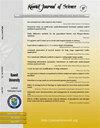热带岩溶区石漠化圈定及潜在土壤流失量估算
IF 1.1
4区 综合性期刊
Q3 MULTIDISCIPLINARY SCIENCES
引用次数: 0
摘要
热带座舱喀斯特以丘陵地形、陡坡、薄土层为特征,极易发生喀斯特石漠化(KRD)。在喀斯特环境中,由于剧烈的土壤侵蚀导致基岩暴露而发生KRD。本研究旨在对座舱喀斯特景观的土壤侵蚀速率进行综合分析,准确评估座舱喀斯特景观的土壤侵蚀速率,并确定影响因子。研究在Gunungsewu喀斯特地区的Seropan地下河集水区进行。利用喀斯特石漠化指数(KRDI)的图像变换方法识别喀斯特石漠化。采用更新后的修正通用土壤流失方程(RUSLE)估算土壤流失量,并加入KRD因子以增强其在喀斯特环境中的适用性。结果表明,KRDI对KRD的识别是非常有效的。大约40%的研究区域表现出中度至重度的KRD水平,主要分布在锥形山丘的斜坡上,其主要驱动因素是森林砍伐、土地开垦为旱地农业和放弃农业用地。估计研究区土壤总流失量为4975.01 t /年,在土壤流失强度水平上贡献最大。强烈到极强烈-严重的土壤流失水平与锥形丘陵的陡坡相关,突出了地形在热带喀斯特环境中土壤退化中的重要作用。本文章由计算机程序翻译,如有差异,请以英文原文为准。
Karst rocky desertification delineation and estimation of potential soil loss in tropical karst cockpits
Tropical cockpit karst, characterized by hilly topography, steep slopes, and thin soil layers, is highly susceptible to land degradation in the form of karst rocky desertification (KRD). KRD occurs due to acute soil erosion in karst environments, leading to the exposure of bedrock. This study aims to provide a comprehensive analysis of KRD, accurately assess soil erosion rates in cockpit karst landscapes, and identify the contributing factors. The research was conducted within the Seropan underground river catchment area in the Gunungsewu Karst region. KRD was identified using an image transformation approach employing the Karst Rocky Desertification Index (KRDI). Soil loss estimation was performed using the updated Revised Universal Soil Loss Equation (RUSLE) method, incorporating the KRD factor to enhance its applicability in karst environments. The results demonstrate that KRDI is highly effective in identifying KRD. Approximately 40 % of the study area exhibits moderate to severe KRD levels, predominantly found on the slopes of conical hills, where the primary driving factors are deforestation, land clearing for dryland agriculture, and abandonment of agricultural land. The estimated total soil loss in the study area is 4975.01 tons per year, with the highest contribution occurring at the intense soil loss level. The intense to extremely intense-severe soil loss levels are correlated with the steep slopes of conical hills, highlighting the significant role of topography in soil degradation within tropical karst environments.
求助全文
通过发布文献求助,成功后即可免费获取论文全文。
去求助
来源期刊

Kuwait Journal of Science
MULTIDISCIPLINARY SCIENCES-
CiteScore
1.60
自引率
28.60%
发文量
132
期刊介绍:
Kuwait Journal of Science (KJS) is indexed and abstracted by major publishing houses such as Chemical Abstract, Science Citation Index, Current contents, Mathematics Abstract, Micribiological Abstracts etc. KJS publishes peer-review articles in various fields of Science including Mathematics, Computer Science, Physics, Statistics, Biology, Chemistry and Earth & Environmental Sciences. In addition, it also aims to bring the results of scientific research carried out under a variety of intellectual traditions and organizations to the attention of specialized scholarly readership. As such, the publisher expects the submission of original manuscripts which contain analysis and solutions about important theoretical, empirical and normative issues.
 求助内容:
求助内容: 应助结果提醒方式:
应助结果提醒方式:


